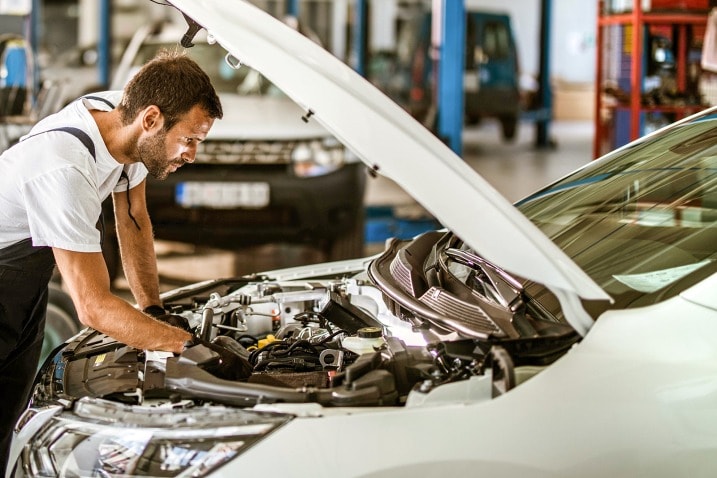All Categories
Featured
Your automobile's suspension system plays a vital function in providing a smooth and steady adventure, guaranteeing that you maintain control on different terrains. Follow these steps to guarantee your suspension system stays in optimal condition.
![]()
Leaking Fluid: Shocks or struts might leakage oil when they're put on. Harmed Springs: A drooping or irregular stance might suggest a busted springtime. Used Bushings or Ball Joints: Splits, rips, or uncommon movement throughout procedure recommend wear. Rust or Deterioration: Over time, metal components might corrode, bring about damaged parts. Deal with any concerns without delay by seeking advice from a specialist technician.
![]()
Feathery Footstep: Indicates poor alignment. Bald Sides: Suggests worn shocks or shows off creating extreme jumping. Rotate your tires regularly and preserve the right tire stress to lower pressure on the suspension system. 3. Change Shocks and Struts When Essential. Shocks and struts are vital to your suspension's efficiency. Indications they need changing consist of:
A bouncy or rough trip. Nose-diving when braking. When turning, extreme body roll. Replacing these components at the advised intervals (every 50,000 to 100,000 miles, depending on driving conditions) can restore ride high quality and handling.
Stay clear of driving over gaps, aesthetics, and rate bumps at high speeds. Take edges delicately to stop too much side pressures. Reduce down on rough roads to decrease deterioration. 6. Arrange Routine Alignments. Wheel placement makes sure that your tires and suspension work sympathetically. Misaligned wheels can trigger steering concerns, unequal tire wear, and added stress on suspension parts. Set up a placement inspect each year or after striking a considerable pothole.
![]()
Conclusion. A well-maintained suspension system enhances driving convenience, enhances safety and security, and prolongs the life of your automobile. By staying aggressive with assessments, resolving issues quickly, and driving responsibly, you can preserve this crucial system for several years to find. Invest in proper suspension upkeep today, and appreciate a safer, smoother experience on every journey.

- Check Suspension Parts On A Regular Basis. Regular visual assessments can assist determine prospective problems early. Seek the complying with indicators:
Leaking Fluid: Shocks or struts might leakage oil when they're put on. Harmed Springs: A drooping or irregular stance might suggest a busted springtime. Used Bushings or Ball Joints: Splits, rips, or uncommon movement throughout procedure recommend wear. Rust or Deterioration: Over time, metal components might corrode, bring about damaged parts. Deal with any concerns without delay by seeking advice from a specialist technician.

- Screen Tire Put On. Uneven tire wear often points to suspension problems. For instance:
Feathery Footstep: Indicates poor alignment. Bald Sides: Suggests worn shocks or shows off creating extreme jumping. Rotate your tires regularly and preserve the right tire stress to lower pressure on the suspension system. 3. Change Shocks and Struts When Essential. Shocks and struts are vital to your suspension's efficiency. Indications they need changing consist of:
A bouncy or rough trip. Nose-diving when braking. When turning, extreme body roll. Replacing these components at the advised intervals (every 50,000 to 100,000 miles, depending on driving conditions) can restore ride high quality and handling.
- Avoid Overloading Your Lorry. Straining your cars and truck places unneeded anxiety on the suspension system. Exceeding your vehicle's weight capacity can cause early wear and minimized performance. Always check your owner's handbook for the maximum load limit and pack as necessary.
- Bear in mind Your Driving Routines. Driving habits dramatically influence the health and wellness of your suspension system. To reduce strain:
Stay clear of driving over gaps, aesthetics, and rate bumps at high speeds. Take edges delicately to stop too much side pressures. Reduce down on rough roads to decrease deterioration. 6. Arrange Routine Alignments. Wheel placement makes sure that your tires and suspension work sympathetically. Misaligned wheels can trigger steering concerns, unequal tire wear, and added stress on suspension parts. Set up a placement inspect each year or after striking a considerable pothole.
- Oil Moving Parts. Some suspension parts, like sphere joints and bushings, take advantage of occasional lubrication. This minimizes friction, decreases wear, and extends their life-span. Inspect your proprietor's guidebook or consult your mechanic for certain lubrication referrals.
- Focus On Routine Professional Inspections. While do it yourself upkeep aids, professional evaluations are vital for identifying surprise problems. Experts can review hard-to-spot issues like used control arms or hidden architectural damages. Routine assessments additionally provide comfort, ensuring all parts are functioning appropriately.

Conclusion. A well-maintained suspension system enhances driving convenience, enhances safety and security, and prolongs the life of your automobile. By staying aggressive with assessments, resolving issues quickly, and driving responsibly, you can preserve this crucial system for several years to find. Invest in proper suspension upkeep today, and appreciate a safer, smoother experience on every journey.
Latest Posts
Find Out Reduce Expenses on Car Maintenance with Montclare Auto Repair’s Limited-Time Deals
Published May 26, 25
1 min read
Uncover Oil Changes & More: Complete Services Guide from Montclare Auto Repair
Published May 25, 25
1 min read
Unlock Your Financial Partner at WyHy – Top Benefits for Your Money Goals
Published May 25, 25
1 min read
More
Latest Posts
Find Out Reduce Expenses on Car Maintenance with Montclare Auto Repair’s Limited-Time Deals
Published May 26, 25
1 min read
Uncover Oil Changes & More: Complete Services Guide from Montclare Auto Repair
Published May 25, 25
1 min read
Unlock Your Financial Partner at WyHy – Top Benefits for Your Money Goals
Published May 25, 25
1 min read